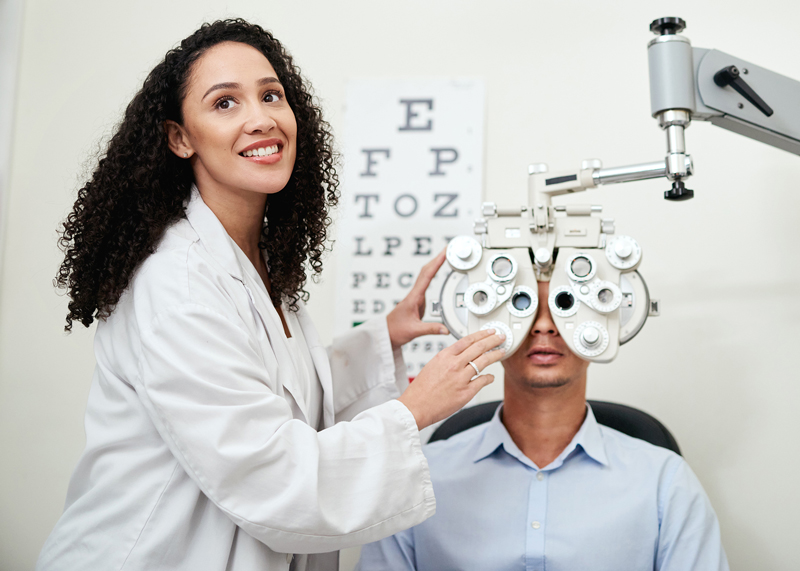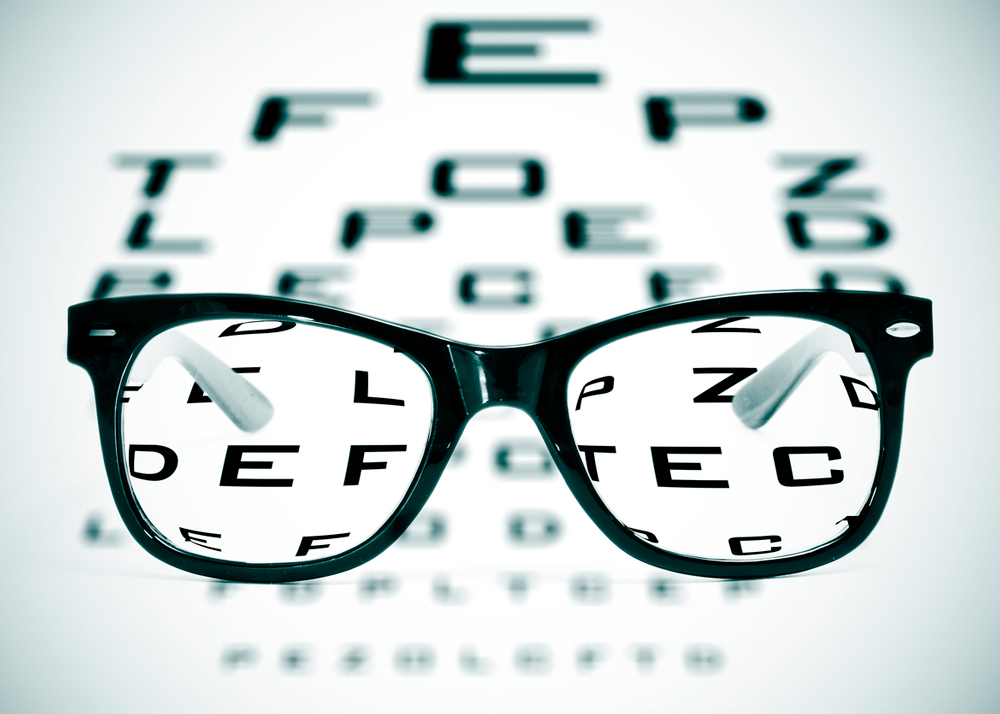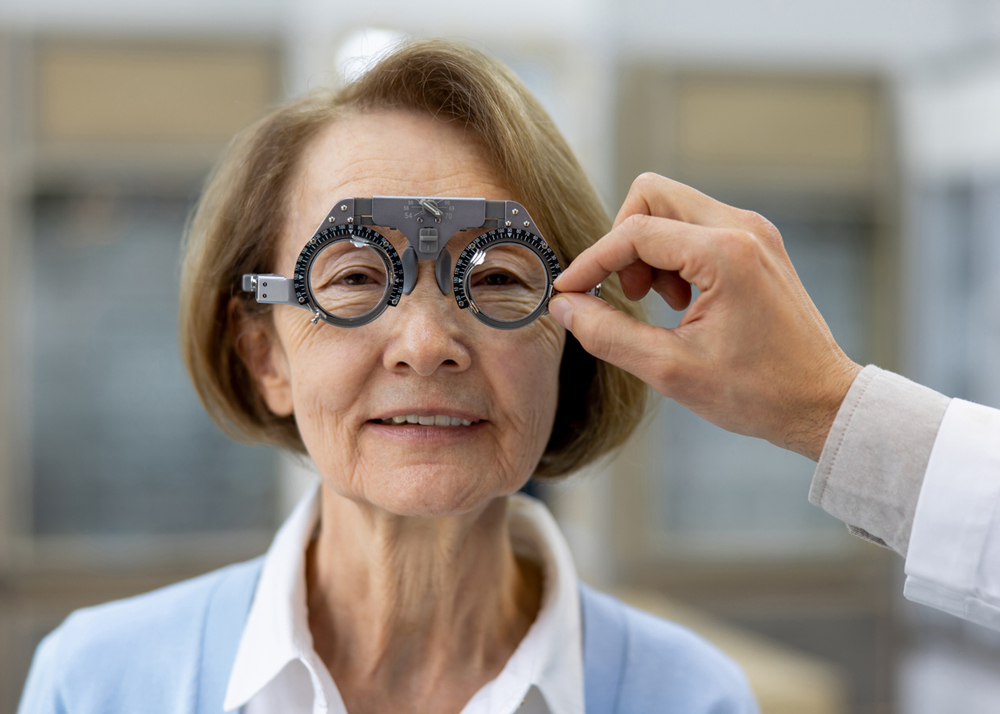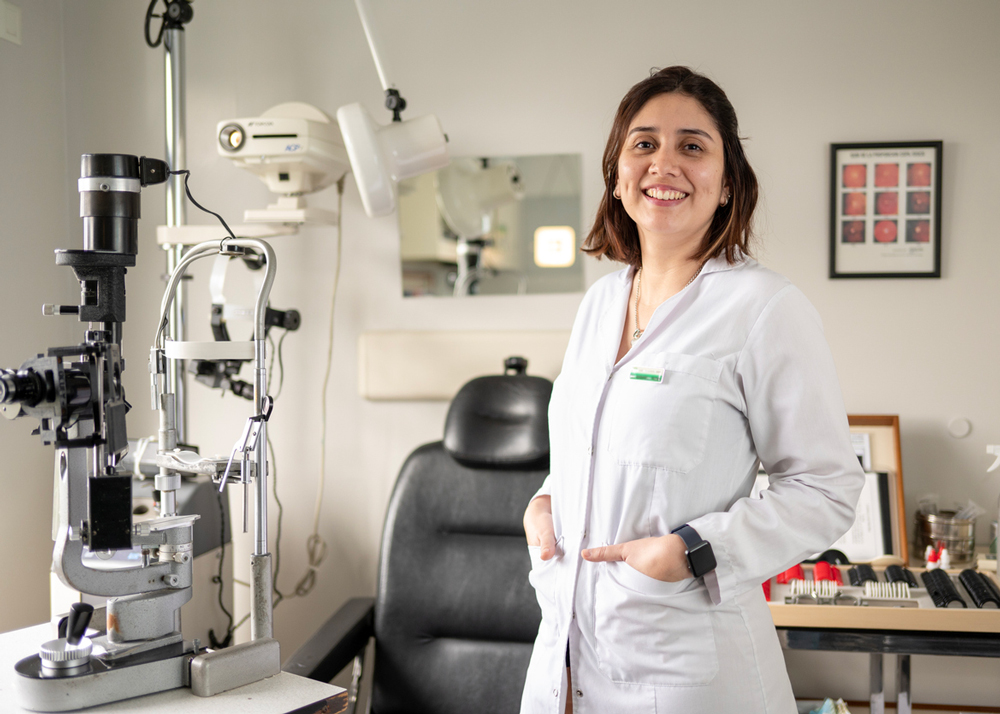Vision 101

Your Guide to Understanding the World of Vision Health
The language of vision is often complex, but understanding the basics when it comes to common eyecare terms will help you be a better advocate for your own vision health and wellness. This guide aims to simplify complicated medical and industry terms, empowering you to make more informed decisions about your eye health.
Common Vision Terms Explained
20/20 vision: An eyechart measures ‘visual acuity’ or the sharpness of ones vision. A person with 20/20 vision can see what an ‘a normally sighted’ individual can see when standing 20 feet away. The top number is the distance in feet from the eyechart. The bottom number is the distance in feet at which the person with normal sight can read the same line. But, if you have 20/100 vision for example, it means that your vision is less sharp and that what you can see at 20 feet, a normally sighted individual can see at 100 feet—5 times further away.
Activities of Daily Living (ADL): Daily self-care activities within an individual’s place of residence, in outdoor environments, or both. ADL includes personal hygiene and grooming, dressing and undressing, self-feeding, functional transfers (getting into and out of bed or wheelchair, getting onto or off the toilet), and bowel and bladder management.
Amsler Grid: A chart used for determining potential changes in central vision and the level of impairment due to those changes. It is often used to detect and follow AMD.
Binocular: Using both eyes; also, a device designed for use with both eyes.
Contrast Sensitivity: The ability to detect differences in grayness and background. There are special tests to measure the loss of contrast which are useful in prescribing optical and non-optical devices and strategies for independent function.
Depth Perception: The ability to determine how far away an object is.
Eccentric Viewing: Not looking directly at an object, but off to its side while still paying attention to the object out of the corner of the eye. This is used when central vision has been diminished.
Functional Vision Loss: How vision loss affects the ability to function and perform activities of daily living.
Legal Blindness: Defined in the United States as central visual acuity of 20/200 or less in the better-seeing eye, which means that what a normally sighted person can see at 200 feet, a legally blind person must move up to 20 feet to see, or visual field restriction to 20 degrees in diameter or less (tunnel vision) in the better-seeing eye.
Low Vision Professional: An eye care or vision rehabilitation professional (usually an optometrist or ophthalmologist) who is trained in the treatment of individuals with low vision, typically including the provision of low vision devices to maximize remaining vision.
Low Vision Services: The examination and accompanying education that leads to and determines which types and powers of devices will be prescribed.
Monocular: Using one eye; also a telescopic device intended for use with one eye.
Orientation and Mobility: Training to help the partially-sighted travel safely and as independently as possible.
Peripheral Vision: The opposite of central vision; in other words, the vision around the outside of the center part of the vision. Peripheral vision is sensitive to motion and supports vision in low light.
Total Blindness: The complete lack of form and visual light perception and is clinically recorded as NLP, an abbreviation for “no light perception.”
Visual Acuity: The ability to see detail (see definition of 20/20 vision above).
Visual Field: The visual field refers to the total area in which objects can be seen.
Visual Perception: The ability to interpret and understand what is seen.

Common Eye Conditions
Age-Related Macular Degeneration (AMD): AMD is a leading cause of vision loss among Americans over age 60 and accounts for nearly half of all low vision cases. It occurs when the part of the eye responsible for sharp, straight-on vision – the macula – breaks down and causes a loss of central vision.
Amblyopia: The loss or lack of development of central vision in one eye that is unrelated to any eye health problem and is not correctable with lenses. Amblyopia is commonly called “lazy eye” and is usually associated with a big difference in eyeglass powers between the two eyes or a turning of one eye (strabismus).
Astigmatism: A common imperfection in the curvature of the eye that can cause blurred vision both near and at a distance.
Cataracts: Commonly caused by aging, diabetes, and excessive exposure to UV light, cataracts result in clouding or yellowing of the lens inside the eye. Symptoms include blurred vision, exaggerated halos around light objects, and glare. Cataract surgery to replace the clouded lens with an artificial lens (IOL) is very common and very successful.
Diabetic Retinopathy: A leading cause of vision loss in persons who are diagnosed with diabetes. Diabetic retinopathy is brought on by leakage of the retinal blood vessels and can develop into progressive blurred vision, double vision, floaters, visual distortion and, ultimately, some degree of severe vision loss.
Dry AMD: Dry AMD (Age-related Macular Degeneration), often called geographic atrophy, is the most common type of macular degeneration and affects 90% of the people who have the condition. In the dry form, there is a breakdown or thinning of the layer of retinal pigment epithelial cells (RPE) at the back of the macula. The retina may also show drusen (yellow crystalline deposits that develop within the macula) and thinning of the macula.
Glaucoma: A sight impairment caused by the intra-ocular pressure (IOP) of the eye being higher than the optic nerve can withstand. While usually glaucoma is caused by a high pressure, some individuals with low pressures can also develop the disease. Permanent impairment can range from loss of peripheral vision to severe vision loss. Symptoms include blurred vision, halos around lights, difficulty seeing in the dark, and sometimes, a pupil that doesn’t change size, eye pain, or even a swollen eye.
Myopia: Another word for nearsightedness, myopia is when you can see objects near clearly but have difficultly seeing objects farther away.
Nystagmus: An involuntary eye movement that can cause the eye to rapidly move from side to side, up and down, or in a circle. This can cause a slight blur in vision. Sometimes people are born with this condition (congenital nystagmus), or can develop it later in life (acquired nystagmus).
Photophobia: Discomfort and/or sensitivity to light.
Presbyopia: An eye disorder starting in middle age, that reduces the ability to focus the eyes for reading and other near vision activities. It is caused by the reduction of the focusing ability of the lens inside the eye. Reading glasses or bifocals are used to easily remedy this condition.
Retinitis Pigmentosa: This is one of the more common forms of inherited retinal degeneration with various end-results, ranging from some significant vision loss to total blindness. Symptoms include night blindness and loss of peripheral vision (tunnel vision).
Stargardt disease: Stargardt disease, also known as fundus flavimaculatus, is a retinal disorder that affects the macula early in life.
Wet AMD: A chronic eye disease that causes vision loss in the center of the field of vision. It is marked by swelling caused by leaking blood vessels that affect the macula. Wet macular degeneration almost always begins as dry macular degeneration. It is currently treated with injections that slow and reverse the development of abnormal blood vessels.

Types of Eyecare Providers
Ophthalmologist: A medical doctor (MD) specializing in the diagnosis and treatment of eye diseases to include the use of therapeutic drugs and surgical procedures.
Optician: A individual who makes, fits and sells glasses according to prescriptions prepared by an optometrist or ophthalmologist.
Optometrist: A eyecare professional (with a Doctor of Optometry degree, abbreviated OD) who examines and tests the eyes for disease and treats visual disorders by prescribing corrective lenses (glasses or contact lenses) and/or vision therapy and low vision aids. In certain states, optometrists are licensed to use diagnostic and therapeutic drugs to treat certain eye disorders.

Industry Organizations
American Optometric Association (AOA): The American Optometric Association, an organization representing more than 48,000+ doctors of optometry (O.D.), optometric professionals and optometry students, works to promote quality care and advocates for our nation’s health.
American Academy of Ophthalmology (AAO): The American Academy of Ophthalmology is the world’s largest association of eye physicians and surgeons. A global community of 32,000 medical doctors, AAO works to protect sight and empower lives by setting the standards for ophthalmic education and advocating for our patients and the public.
The Vision Council: The Vision Council brings the power of sight to all through education, government relations, research, and technical standards. A leading advocate for the optical industry, the association positions its members to deliver the eyewear and eyecare people need to look and feel their best. Vital to health, independence and safety, better vision leads to better lives.
The Vision Council Foundation: The Vision Council Foundation brings the power of sight to all through eye health educational programs and optical industry career training support. The Vision Council Foundation is a 501c3 charitable nonprofit organization dedicated to enabling better vision for better lives.
Prevent Blindness: With a mission to prevent blindness and preserve sight, Prevent Blindness educates the public about eye health, advocates for vision-related policies, and provides resources for vision screening and eye safety programs.
International Agency for the Prevention of Blindness (IAPB): The IAPB is a global alliance of organizations committed to eliminating avoidable blindness and promoting vision care worldwide through advocacy, partnerships, and capacity-building initiatives.
United Opticians Association (UOA): The UOA is a model Opticianry Association representing over 80,000 Opticians and Contact Lens Professionals. In 2024, the UOA was established as a result of a merger of the Opticians Association of America and the National Federation of Opticianry Schools.

